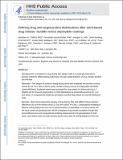| dc.contributor.author | Tzafriri, Abraham R. | |
| dc.contributor.author | Garcia-Polite, Fernando | |
| dc.contributor.author | Li, Xiaojian | |
| dc.contributor.author | Keating, John | |
| dc.contributor.author | Balaguer, Josep-Maria | |
| dc.contributor.author | Zani, Brett | |
| dc.contributor.author | Bailey, Lynn | |
| dc.contributor.author | Markham, Peter | |
| dc.contributor.author | Kiorpes, Timothy C. | |
| dc.contributor.author | Carlyle, Wenda | |
| dc.contributor.author | Edelman, Elazer R | |
| dc.date.accessioned | 2020-07-21T21:03:14Z | |
| dc.date.available | 2020-07-21T21:03:14Z | |
| dc.date.issued | 2018-03 | |
| dc.date.submitted | 2017-12 | |
| dc.identifier.issn | 0168-3659 | |
| dc.identifier.uri | https://hdl.handle.net/1721.1/126297 | |
| dc.description.abstract | Background: Innovations in drug eluting stent designs make it increasingly important to develop models for differentiating performance through spatial definition of drug, receptor binding and cell state. Methods: Two designs of sirolimus analog eluting stents were implanted into porcine coronary arteries for 28, 60 or 90 days (n = 9/time point), durable coating (Xience) and deployable absorbable coating (MiStent). Explanted arteries were evaluated for drug content (n = 3/time point) by LC-MS/MS and for drug and target protein (mTOR) distributions by immunofluorescence (IF, n = 6/time point). A computational model was developed to predict drug release and arterial distribution maps. Results: Both stents released the majority of drug load by 28 days, with different tissue retention efficiencies (91.4 ± 4.9% MiStent versus 21.5 ± 1.9% Xience, P < 0.001). Computational modeling of MiStent coating deployment and microcrystal dissolution recapitulated in vivo drug release and net tissue content and predicted that >98.5% of deployed drug remains crystalline through 90 days. Immunofluorescence and computational modeling showed peristrut drug localization for both stents, with similar peaks, but high interstrut levels only at sites of coating deployment from the absorbable coating. Co-localization of mTOR-IF with drug-IF for both devices showed persistent drug effects, though with differential drug–receptor pharmacokinetics. Conclusions: Immunofluorescence and computational modeling provide insights into drug distribution and binding status that can help differentiate drug delivery technologies. Herein we found that tissue deployment of slow dissolving crystalline drug particles results in temporally and spatially more uniform drug delivery to interstrut zones that might otherwise be under-dosed without excess peristrut drug. | en_US |
| dc.description.sponsorship | National Institutes of Health (Grant R01-GM-49039) | en_US |
| dc.language.iso | en | |
| dc.publisher | Elsevier BV | en_US |
| dc.relation.isversionof | http://dx.doi.org/10.1016/j.jconrel.2018.02.007 | en_US |
| dc.rights | Creative Commons Attribution-NonCommercial-NoDerivs License | en_US |
| dc.rights.uri | http://creativecommons.org/licenses/by-nc-nd/4.0/ | en_US |
| dc.source | PMC | en_US |
| dc.title | Defining drug and target protein distributions after stent-based drug release: Durable versus deployable coatings | en_US |
| dc.type | Article | en_US |
| dc.identifier.citation | Tzafriri, Abraham R. et al. "Defining drug and target protein distributions after stent-based drug release: Durable versus deployable coatings." Journal of Controlled Release 274 (March 2018): 102-108 © 2018 Elsevier | en_US |
| dc.contributor.department | Massachusetts Institute of Technology. Institute for Medical Engineering & Science | en_US |
| dc.relation.journal | Journal of Controlled Release | en_US |
| dc.eprint.version | Author's final manuscript | en_US |
| dc.type.uri | http://purl.org/eprint/type/JournalArticle | en_US |
| eprint.status | http://purl.org/eprint/status/PeerReviewed | en_US |
| dc.date.updated | 2019-10-09T17:50:56Z | |
| dspace.date.submission | 2019-10-09T17:50:59Z | |
| mit.journal.volume | 274 | en_US |
| mit.metadata.status | Complete | |
